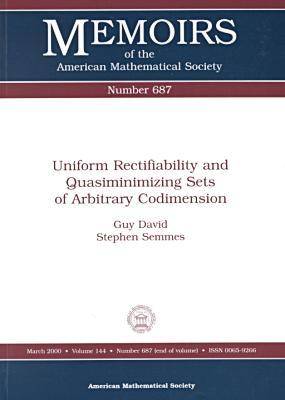
Roughly speaking, a $d$-dimensional subset of $\mathbfR^n$ is minimizing if arbitrary deformations of it (in a suitable class) cannot decrease its $d$-dimensional volume. For quasiminimizing sets, one allows the mass to decrease, but only in a controlled manner. To make this precise we follow Almgren's notion of 'restricted sets' [{\textbold 2}]. Graphs of Lipschitz mappings $f\:\mathbfR^d \to \mathbfR^{n-d}$ are always quasiminimizing, and Almgren showed that quasiminimizing sets are rectifiable. Here we establish uniform rectifiability properties of quasiminimizing sets, which provide a more quantitative sense in which these sets behave like Lipschitz graphs. (Almgren also established stronger smoothness properties under tighter quasiminimality conditions.)Quasiminimizing sets can arise as minima of functionals with highly irregular 'coefficients'. For such functionals, one cannot hope in general to have much more in the way of smoothness or structure than uniform rectifiability, for reasons of bilipschitz invariance. (See also [{\textbold 9}].) One motivation for considering minimizers of functionals with irregular coefficients comes from the following type of question. Suppose that one is given a compact set $K$ with upper bounds on its $d$-dimensional Hausdorff measure, and lower bounds on its $d$-dimensional topology.What can one say about the structure of $K$? To what extent does it behave like a nice $d$-dimensional surface? A basic strategy for dealing with this issue is to first replace $K$ by a set which is minimizing for a measurement of volume that imposes a large penalty on points which lie outside of $K$. This leads to a kind of regularization of $K$, in which cusps and very scattered parts of $K$ are removed, but without adding more than a small amount from the complement of $K$. The results for quasiminimizing sets then lead to uniform rectifiability properties of this regularization of $K$. To actually produce minimizers of general functionals it is sometimes convenient to work with (finite) discrete models. A nice feature of uniform rectifiability is that it provides a way to have bounds that cooperate robustly with discrete approximations, and which survive in the limit as the discretization becomes finer and finer.
| ISBN: | 9780821820483 |
| Publication date: | 30th March 2000 |
| Author: | |
| Publisher: | American Mathematical Society |
| Format: | Paperback |
| Series: | Memoirs of the American Mathematical Society |
| Genres: |
Calculus of variations Optimization Calculus and mathematical analysis |